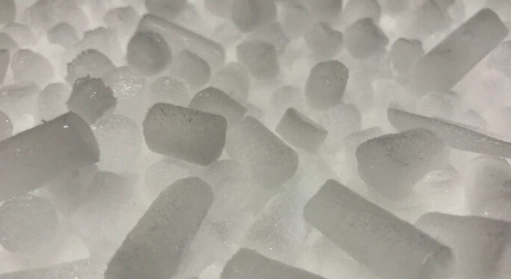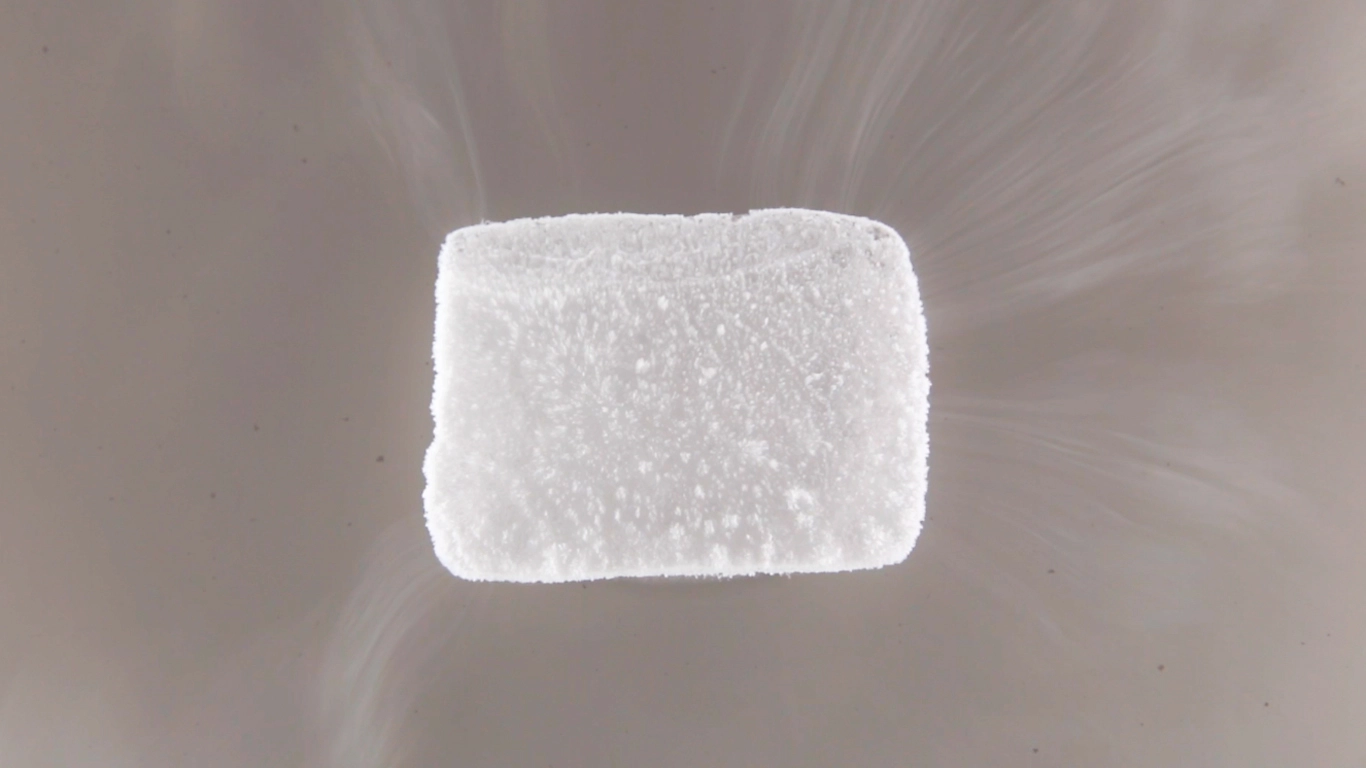When most people think of dry ice, they might picture Halloween party fog effects or shipping ice cream. However, this unique substance—solid carbon dioxide that sublimates directly from solid to gas at -78.5°C (-109.3°F)—plays a crucial role in numerous industries worldwide. Its exceptional cooling properties and clean sublimation make it indispensable for applications where traditional ice or refrigeration systems fall short.
In this article, we'll explore the five major industries that depend on dry ice daily, examining how this remarkable substance enables critical processes, preserves valuable products, and solves unique challenges across diverse sectors. You can find suppliers for your needs in our dry ice directory.
Dry Ice: The Basics
Dry ice is solid carbon dioxide (CO₂) that sublimates (transitions directly from solid to gas) at -78.5°C (-109.3°F). It's produced by compressing and cooling gaseous CO₂ until it liquefies, then reducing the pressure to create solid CO₂ "snow" which is compressed into blocks or pellets.
Unlike regular ice, dry ice:
- Is approximately 3-4 times colder than water ice
- Leaves no liquid residue (hence "dry" ice)
- Creates gaseous CO₂ as it warms
- Requires special handling due to its extreme cold temperature
Industry #1: Healthcare and Pharmaceuticals
Healthcare and Pharmaceuticals
Perhaps no industry has demonstrated the critical importance of dry ice more visibly than healthcare, especially during the COVID-19 pandemic when temperature-sensitive vaccines required ultra-cold storage and transportation.

Key Applications:
- Vaccine Transportation: Many vaccines, including some COVID-19 vaccines, require temperatures as low as -70°C (-94°F) during shipping and storage. Dry ice provides a reliable, portable cooling solution that doesn't require electricity.
- Biological Sample Preservation: Tissue samples, blood components, and other biological materials must be kept at precise temperatures to maintain viability. Dry ice allows for the safe transport of these materials between medical facilities and laboratories.
- Dermatological Treatments: Medical professionals use dry ice for cryotherapy treatments to remove warts, skin tags, and other benign skin growths. The extreme cold destroys targeted tissue with minimal damage to surrounding areas.
- Laboratory Research: Research facilities use dry ice to flash-freeze samples, preserve specimens, and maintain cold temperatures for sensitive experiments and procedures.
Industry Impact:
The healthcare industry's reliance on dry ice became headline news during the COVID-19 pandemic when concerns about potential shortages arose due to the massive demand for vaccine distribution. This highlighted how critical this simple substance is to modern medical infrastructure and public health initiatives.
According to industry reports, a single large hospital or research center may use hundreds of pounds of dry ice weekly for various applications, from preserving tissue samples to shipping diagnostic specimens.
Industry #2: Food Production and Distribution
Food Production and Distribution
The food industry relies heavily on dry ice for everything from production processes to last-mile delivery of perishable goods. Its food-safe properties and powerful cooling capabilities make it ideal for numerous applications throughout the food supply chain.

Key Applications:
- Flash Freezing: Food manufacturers use dry ice to rapidly freeze products, preserving quality and minimizing ice crystal formation that can damage food texture. This technique is particularly important for premium seafood, berries, and other delicate items.
- Temperature Control During Production: Many food production processes require precise temperature control. Dry ice can be used to cool mixers, grinders, and other equipment to prevent heat-sensitive ingredients from warming during processing.
- Meal Kit and Grocery Delivery: The booming meal kit and online grocery industries rely on dry ice to keep perishable foods at safe temperatures during shipping, especially for last-mile delivery when traditional refrigeration isn't available.
- Catering and Food Presentation: Beyond its practical applications, dry ice creates the dramatic "smoking" effect used in food presentation at high-end restaurants and catering events.
- Pest Control: Food storage facilities use dry ice for non-toxic pest control, as the released CO₂ displaces oxygen in enclosed spaces, eliminating pests without chemical residues.
Industry Impact:
The rise of direct-to-consumer food delivery has dramatically increased dry ice demand in the food sector. A single meal kit company may use tens of thousands of pounds of dry ice weekly to ensure food safety during shipping.
According to industry estimates, the food sector accounts for approximately 30% of all dry ice consumption in the United States, making it one of the largest industrial users of this substance.
Industry #3: Manufacturing and Industrial Cleaning
Manufacturing and Industrial Cleaning
Manufacturing facilities across various sectors have adopted dry ice blasting as an environmentally friendly and highly effective cleaning method. This innovative application has revolutionized how industries approach equipment maintenance and cleaning challenges.

Key Applications:
- Dry Ice Blasting: This cleaning method propels dry ice pellets at high speeds toward surfaces requiring cleaning. Upon impact, the dry ice creates a micro-thermal shock that breaks the bond between the contaminant and the surface, then immediately sublimates, leaving no secondary waste.
- Mold Remediation: Manufacturing facilities use dry ice blasting to remove mold from equipment and structures without water damage or chemical residues.
- Production Line Cleaning: Food processing equipment, printing presses, automotive assembly lines, and other manufacturing equipment can be cleaned in place without disassembly or lengthy downtime.
- Historic Restoration: Dry ice blasting gently removes contaminants from delicate surfaces, making it ideal for restoring historic buildings, monuments, and artifacts.
- Fire Damage Cleanup: The technique effectively removes soot and smoke damage without additional water that could cause further damage.
Industry Impact:
Dry ice blasting has transformed industrial cleaning by reducing downtime, eliminating chemical waste, and providing superior cleaning results. A manufacturing facility that previously needed to shut down for days for cleaning and maintenance can now complete the same work in hours using dry ice blasting techniques.
The environmental benefits are substantial as well. Traditional industrial cleaning methods often generate significant wastewater requiring treatment, while dry ice blasting produces no secondary waste stream—the dry ice simply sublimates into the atmosphere as carbon dioxide.
Industry #4: Shipping and Logistics
Shipping and Logistics
The global shipping and logistics industry faces the constant challenge of maintaining temperature-sensitive products during transport. Dry ice provides a reliable, portable cooling solution that works independently of power sources or mechanical refrigeration.

Key Applications:
- Pharmaceutical Cold Chain: Temperature-sensitive medications, vaccines, and biological materials require precise temperature control during shipping. Dry ice provides the ultra-cold temperatures needed for many of these products.
- Perishable Food Transport: From premium seafood to specialty desserts, many high-value food items are shipped with dry ice to maintain quality and safety.
- International Shipping: When products must cross international borders or travel long distances, dry ice provides reliable cooling that doesn't depend on electrical power or mechanical refrigeration that could fail.
- Last-Mile Delivery: The final leg of delivery often lacks refrigeration infrastructure. Dry ice enables temperature-sensitive products to reach their final destination safely.
- Emergency Response: During power outages or natural disasters, dry ice becomes critical for preserving medications, vaccines, and food supplies when traditional refrigeration is unavailable.
Industry Impact:
The shipping and logistics industry consumes enormous quantities of dry ice daily. A single international air freight company might use several tons of dry ice per day for shipping temperature-sensitive products globally.
The COVID-19 pandemic highlighted the critical role of dry ice in global logistics, as billions of vaccine doses required cold-chain shipping solutions. This unprecedented demand led to temporary dry ice shortages and prompted many shipping companies to increase their dry ice production capabilities.
Industry #5: Entertainment and Special Effects
Entertainment and Special Effects
While perhaps less critical than medical or food applications, the entertainment industry is one of the most visible users of dry ice. The distinctive fog effect created when dry ice sublimates has become a staple in theater productions, concerts, films, and special events.

Key Applications:
- Theatrical Fog Effects: Theater productions use dry ice to create low-lying fog that crawls along the stage floor, creating atmospheric effects for scenes involving mist, fog, or supernatural elements.
- Film and Television: Production studios use dry ice fog for horror scenes, dream sequences, and to create mysterious atmospheres without the respiratory irritation sometimes caused by chemical fog machines.
- Concert and Stage Shows: Musicians and performers incorporate dry ice effects to enhance visual impact during performances.
- Halloween and Themed Events: Haunted houses, themed parties, and seasonal events use dry ice to create spooky or magical atmospheres.
- Food Presentation: High-end restaurants and catering services use dry ice to create dramatic smoking effects when presenting specialty dishes and cocktails.
Industry Impact:
While the entertainment industry may not consume as much dry ice by volume as healthcare or food production, it represents one of the most creative applications of this versatile substance. A major theatrical production or concert tour might use hundreds of pounds of dry ice nightly to create the perfect atmospheric effect.
The visual impact of dry ice fog has become so iconic that it's immediately recognizable to audiences worldwide, creating instant associations with mystery, magic, or the supernatural—a testament to how deeply this industrial product has penetrated popular culture.
Emerging Applications and Future Trends
Beyond these five major industries, dry ice continues to find new applications as technology evolves:
- Additive Manufacturing: Some 3D printing processes use dry ice to create temporary support structures that simply sublimate away after printing, leaving no residue.
- Carbon Capture: Research into carbon capture technologies sometimes involves converting captured CO₂ into solid form (effectively dry ice) as part of sequestration processes.
- Advanced Materials Processing: Certain specialized manufacturing processes use the extreme cold of dry ice to achieve specific material properties.
- Disaster Recovery: Following natural disasters, dry ice becomes essential for preserving food and medications when power infrastructure is damaged.
Environmental Considerations
While dry ice is composed of carbon dioxide, a greenhouse gas, its production typically captures CO₂ that would otherwise be released into the atmosphere as a byproduct of other industrial processes. Rather than creating new CO₂ emissions, dry ice production generally utilizes existing carbon dioxide that would otherwise be vented directly to the atmosphere.
Additionally, the development of more energy-efficient production methods and the use of renewable energy sources for dry ice manufacturing are helping to reduce its overall carbon footprint.
The Dry Ice Supply Chain
The industries highlighted above depend on a reliable supply of dry ice, which presents unique challenges:
- Local Production: Due to sublimation, dry ice must typically be produced relatively close to where it will be used, leading to distributed production facilities across the country.
- Just-in-Time Delivery: Since dry ice constantly sublimates, suppliers must coordinate closely with users to ensure delivery shortly before use.
- Specialized Transport: Moving dry ice requires vehicles with proper ventilation and handling protocols.
- Production Capacity: During peak demand periods (like vaccine distribution campaigns or holiday food shipping), production capacity can become strained.
Finding reliable dry ice suppliers is critical for businesses in these industries. Our comprehensive directory can help connect businesses with reputable dry ice suppliers across the United States.
Conclusion
From preserving life-saving vaccines to creating spooky Halloween effects, dry ice plays a surprisingly central role in numerous industries. Its unique properties—extreme cold, clean sublimation, and non-toxic nature—make it irreplaceable for many applications where conventional refrigeration or cooling methods fall short.
As technology advances and supply chains become increasingly global, the demand for dry ice continues to grow. Understanding the diverse applications of this versatile substance helps appreciate its importance to modern industry and everyday life.
Whether you're a business owner needing dry ice for your operations or simply curious about this fascinating substance, exploring its many uses reveals how something seemingly simple can be absolutely essential to complex industrial processes and supply chains worldwide.